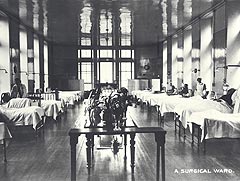Hospitals before the NHS
Staff shortages, long waiting lists, cash crises and hospital infections were all evident in Scotland long before the NHS.
The old system of voluntary and municipal hospitals was plagued by them.
The stated purpose of most voluntary hospitals was to treat the “sick poor”. Unlike in England, most did not charge patients for treatment.
Affluent patients tended to be treated at home or in private nursing rooms. Consultants usually worked unpaid in the voluntary hospitals, relying on outside private practice for their income.
Municipal hospitals run by local authorities were a product of the welfare system created by historic Poor Law legislation. In many people’s eyes, this also carried the stigma of the workhouse.
Waiting and building
Waiting lists grew longer in the 1920s and 1930s.
In Edinburgh the list for gynaecology had reached 2800 by 1929. A new wing in the proposed Simpson Maternity Hospital was promised in the fund raising appeal where the public were urged to give one shilling, raising a total of £45,000.
The Simpson finally opened in 1939 after eleven years of discussion and five of building.
Other areas were more successful. Aberdeen led the way with Matthew Hay’s vision for a new medical campus at Foresterhill bringing all services, teaching and research on one site. Building started in 1926. By the advent of war Foresterhill already had a new infirmary, children and maternity hospitals and medical school.
Mearnskirk in Renfrewshire opened in 1930 providing 500 orthopaedic beds for children with tuberculosis (TB). Lennox Castle was another Glasgow Corporation hospital, completed in 1936 with 1200 beds.
Local authorities retained some responsibilities under the NHS providing public health and community services and Medical Officers of Health.
The end of the collecting tin
By 1939 the old system was already teetering on the verge of financial collapse.
The Royal Hospital for Sick Children in Edinburgh ran an annual deficit of £5000 in 1938. By 1947 this had mushroomed to more than £40,000.
“In wishing their successors well, the Directors express the hope that the spirit of public service, which has built up the Voluntary Hospital System, will continue to animate the Health Service of the future,” the hospital’s directors noted on the eve of the NHS.
Why was the old system mourned?
People retained some affection for it. They did not like going into hospital but they felt comfort that it was there.
This bond was reinforced every time a collecting tin was rattled at countless fund raising events and flag days. This provided income for the voluntary hospitals as it had done for decades. It also continued in years to come through various appeals for equipment as new technology delivered ever more advances and increased financial pressures capped the ambitions of the NHS.
- Further information
- Mearnskirk hospital
- Matthew Hay
- Lothian 1948 archive photographs

“There are many persons in Scotland who, mainly because there are not enough hospital beds, are unable to get at the proper time the hospital treatment which they need.
“For all those persons, the shortage of beds means a prolongation of their suffering; for some it means that treatment is delayed beyond the stage when effective treatment is possible; and for a few, it may mean that they die before they can be admitted to hospital.”
Scottish Board of Health’s Hospital Services Committee 1924
“Those of us who grieve most must confess we could not carry on very much longer as a purely voluntary institution. . . .
“Sooner or later we should have had to press for State assistance. Even those, like myself, whose hearts have been with the voluntary system feel it is probably the best thing to do, to hand it over with good grace and wish them Godspeed”
John Little, chairman of the Edinburgh Royal Infirmary board, at a thanksgiving service, Usher Hall, July 4 1948
